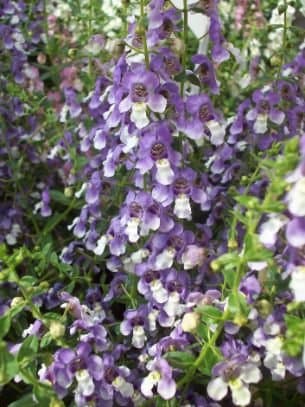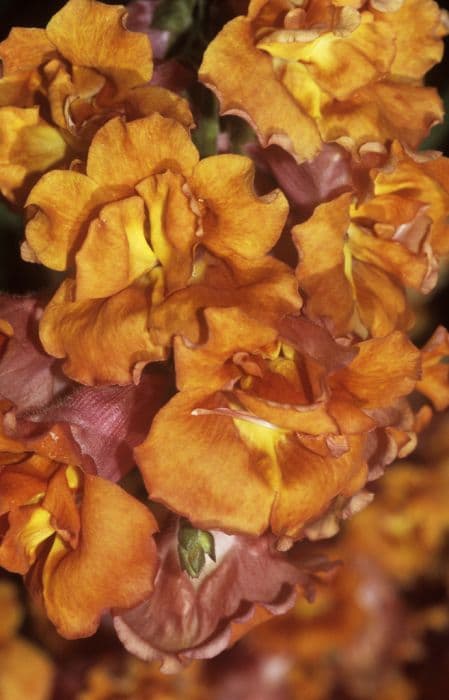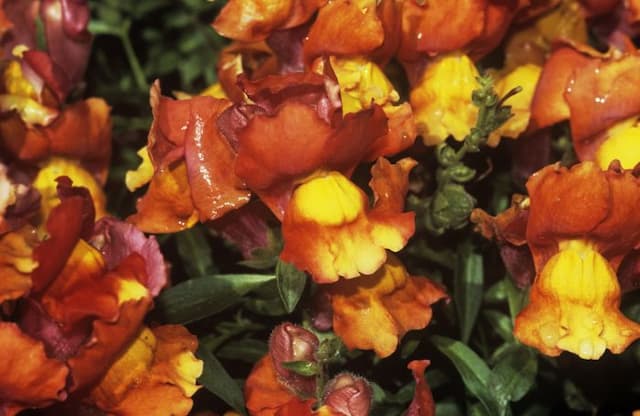Penstemon 'Pensham Freshwater Pearl' Penstemon 'Pensham Freshwater Pearl' (Pensham Series)

ABOUT
This selection has flared, tubular flower in pale lavender-pink with a white throat. Height to 1m
About this plant
 Names
NamesFamily
Plantaginaceae
Synonyms
Beardtongue, Penstemon
Common names
Penstemon 'Pensham Freshwater Pearl'.
 Characteristics
CharacteristicsLife cycle
Perennials
Foliage type
Deciduous
Color of leaves
Green
Flower color
White
Height
2-3 feet (60-90 cm)
Spread
2 feet (60 cm)
Plant type
Herb
Hardiness zones
7
Native area
North America
Benefits
 General Benefits
General Benefits- Aesthetic Appeal: Adds visual interest with its elegant white blooms with flushed pink throats, enhancing the beauty of gardens.
- Pollinator Friendly: Attracts bees, butterflies, and other pollinators, supporting biodiversity.
- Drought Tolerance: Once established, demonstrates a strong tolerance to drought, reducing the need for frequent watering.
- Long Blooming Season: Offers a lengthy flowering period from early summer into the fall, providing color for extended periods.
- Hardy Nature: Adapts well to various climates and is hardy to USDA zones 4-9, ensuring wide cultivability.
- Low Maintenance: Requires minimal care once established, making it an ideal choice for gardeners of all levels.
- Versatility: Suitable for mixed borders, cottage gardens, and rock gardens, offering various landscaping possibilities.
- Deer Resistance: Less appealing to deer, which helps to prevent damage to the plant and maintains its appearance.
 Medical Properties
Medical PropertiesThis plant is not used for medical purposes.
 Air-purifying Qualities
Air-purifying QualitiesThis plant is not specifically known for air purifying qualities.
 Other Uses
Other Uses- Creating a sensory garden: Penstemon, with its tubular flowers, can add texture and visual stimuli to a garden designed for therapeutic or educational purposes.
- Educational tool: Because of its unique morphology, Penstemon can be used to teach plant anatomy and pollination strategies in horticultural courses.
- Artistic inspiration: Artists and photographers may use Penstemon as a subject for their work, capturing its delicate form and hue.
- Nectar source for homemade syrups: Some gardeners use the nectar from Penstemon flowers to flavor homemade syrups and sweetenings, although this usage is not common.
- Floral arrangements: Fresh or dried, Penstemon flowers can be incorporated into bouquets and other floral compositions.
- Crafting: The sturdy stems and colorful flowers of Penstemon can be used in making dried flower crafts, such as wreaths and wall hangings.
- Pen pal communities: Penstemon can be a focal plant for plant-swap clubs and pen pal groups that exchange seeds and gardening experiences.
- Theme gardens: Penstemon 'Pensham Freshwater Pearl' can be an addition to a pearl or gemstone-themed garden due to its pearl-like flower coloration.
- Companion planting: Penstemon can be planted to complement the colors and growth patterns of nearby plants, enhancing overall garden aesthetics.
- Culinary garnish: The flowers, being non-toxic, could be used as garnish for salads and desserts, adding a splash of color to the dishes.
Interesting Facts
 Feng Shui
Feng ShuiThe Penstemon is not used in Feng Shui practice.
 Zodiac Sign Compitability
Zodiac Sign CompitabilityThe Penstemon is not used in astrology practice.
 Plant Symbolism
Plant Symbolism- Stability: The Penstemon, with its sturdy stem and upright posture, represents resilience and the ability to stand firm amidst life’s challenges.
- Strength: As Penstemons can thrive in tough conditions, they symbolize inner strength and the power to overcome adversity.
- Diversity: With the wide variety of colors and forms in the Penstemon family, they reflect the beauty of diversity and the importance of embracing differences.
- Health: Traditionally, some Penstemon species were used for their purported healing properties, making them a symbol of good health and physical well-being.
- Attractiveness: The striking blossoms of the Penstemon ‘Pensham Freshwater Pearl’ can symbolize the allure and captivating beauty found in nature.
- Communication: In the language of flowers, Penstemons can convey the desire to talk or communicate, as their blooms are reminiscent of an open mouth.
 Water
WaterBeardtongues, like the Penstemon 'Pensham Freshwater Pearl', prefer to be watered thoroughly but allowed to dry out between waterings. Water the plant deeply once a week, providing about 1 gallon of water per plant each time, ensuring moisture reaches the root zone. During the hotter, drier months, you may need to water twice a week, while in cooler or rainy periods, reduce the frequency. Overwatering or allowing the plant to sit in wet soil can lead to root rot, so ensure proper drainage. Adjust the watering schedule based on the plant's environment and signs of stress.
 Light
LightBeardtongues thrive in full sun to partial shade. Choose a spot where the Penstemon 'Pensham Freshwater Pearl' will receive at least six hours of sunlight daily. Morning sun with afternoon shade is ideal in regions with very hot summers, but in cooler climates, a full day of sun encourages better blooms.
 Temperature
TemperatureBeardtongues prefer moderate to warm temperatures, with the Penstemon 'Pensham Freshwater Pearl' thriving best between 60 to 75°F. They can survive in temperatures as low as 20°F, but prolonged exposure can damage the plant. They do not tolerate extreme heat very well either, and temperatures consistently above 90°F may cause stress.
 Pruning
PruningPrune Beardtongues in late winter or early spring to promote vigorous growth and abundant flowering. Remove dead or damaged stems of Penstemon 'Pensham Freshwater Pearl' and cut back approximately a third of the plant to shape it and encourage new growth. Deadhead spent flowers throughout the season to prolong blooming.
 Cleaning
CleaningAs needed
 Soil
SoilBeardtongue prefers well-draining soil with a pH between 6.0 and 8.0. A mix of loam, sand, and compost is ideal, ensuring that the soil is fertile but not overly rich which could promote foliage over flower growth.
 Repotting
RepottingRepot Beardtongue every 2-3 years or when you observe root crowding. Spring is the best time to repot to give the plant time to establish before winter.
 Humidity & Misting
Humidity & MistingBeardtongue thrives in average humidity levels but does well in drier conditions, which mimic its native, semi-arid habitats.
 Suitable locations
Suitable locationsIndoor
Place Beardtongue in bright light, avoid soggy soil.
Outdoor
Full sun, well-drained soil, protect from extreme cold.
Hardiness zone
4-9 USDA
 Life cycle
Life cyclePenstemon 'Pensham Freshwater Pearl', commonly known as beardtongue, begins its life as a seed, which upon germinating in the spring, develops into a small seedling. As the seedling grows, it forms a rosette of leaves at ground level and starts to establish a strong root system. With adequate sunlight, water, and nutrients, the beardtongue then enters a vegetative state where it focuses energy on producing more foliage and reaching maturity. During early to mid-summer, it transitions into the flowering stage, producing a show of tubular flowers that are attractive to pollinators such as bees and hummingbirds. After pollination, the flowers give way to seed capsules which eventually dry and release seeds, completing the reproductive cycle. Beardtongue is a perennial plant, so after the flowering season, it will enter a period of dormancy during the winter, conserving energy to regrow the following spring.
 Propogation
PropogationPropogation time
Spring-Early Summer
Penstemon 'Pensham Freshwater Pearl', commonly referred to as beardtongue, is often propagated through stem cuttings. The ideal time for taking stem cuttings for propagation is late spring to early summer when the plant is actively growing. For propagation, a gardener should select a healthy non-flowering stem and cut a length of approximately 4 to 6 inches (10 to 15 cm) just below a node. The lower leaves are removed, and the base of the cutting is dipped in rooting hormone to encourage root development. This cutting is then inserted into a pot filled with a well-draining potting mix, ensuring that the node where the leaves were removed is buried beneath the soil. The pot should be placed in a warm, bright location out of direct sunlight and kept consistently moist. Roots typically establish within a few weeks, after which the new plant can gradually be acclimated to outdoor conditions before being transplanted to its final location in the garden.









